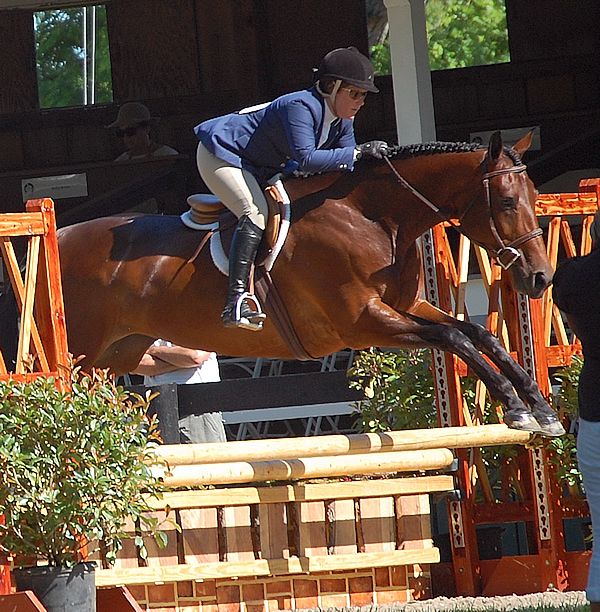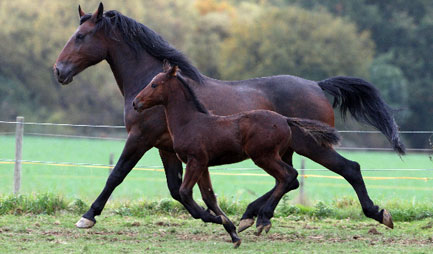The Cleveland Bay is a breed of horse that originated in England during the 17th century, named after its colouring and the Cleveland district of Yorkshire. Originally developed in the Cleveland district of Yorkshire, England, the Cleveland Bay is said to be the oldest established English horse breed, and the only horse native to Britain that does not belong to the heavy horse group.
The horses are always bay in color, although a few light hairs in the mane and tail are characteristic of some breed lines.
It is a well-muscled horse, with legs that are strong but short in relation to the body.

The ancestors of the breed were developed during the Middle Ages for use as pack horses, when they gained their nickname of “Chapman Horses.” These pack horses were crossbred with Andalusian and Barb blood, and later with Arabians and Thoroughbreds, to create the Cleveland Bay of today.
Over the years, the breed became lighter in frame as they were employed more as carriage and riding horses.
The popularity of the Cleveland Bay has greatly fluctuated since it was first imported to the United States in the early 19th century. Despite serious declines in the population after Second World War, the breed has experienced a resurgence in popularity since the 1970s, although only around 550 horses existed worldwide as of 2006.
They have been patronized by members of the royal family throughout their history, and they are still used to pull carriages in royal processions today. The breed has also been used to develop and improve several warmblood and draught horse breeds.
Today they are used for farm work and driving, as well as under-saddle work. They are particularly popular for fox hunting and show jumping, both pure blooded and when crossed with Thoroughbreds.
The Cleveland Bay is a rare breed, and both the United Kingdom-based Rare Breeds Survival Trust and the United States-based American Livestock Breeds Conservancy consider the population to be at critical limits for extinction.
Physical Traits of the Cleveland Bay
 The Cleveland Bay generally stands between 16 and 16.2 hands (64 and 66 inches, 163 and 168 cm), and is always bay in colour. Bright bay horses (bays with a more reddish tint than normal) are the most preferred by breeders, followed by ordinary bay, dark bay and then light bay. This preference for brighter shades of bay was originally stated in the official breed standard, although this stipulation has since been removed.
The Cleveland Bay generally stands between 16 and 16.2 hands (64 and 66 inches, 163 and 168 cm), and is always bay in colour. Bright bay horses (bays with a more reddish tint than normal) are the most preferred by breeders, followed by ordinary bay, dark bay and then light bay. This preference for brighter shades of bay was originally stated in the official breed standard, although this stipulation has since been removed.
In some bloodlines of the breed, light, grayish hairs in the mane and tail are known as a characteristic of pure blood. White markings, except for a small star on the forehead, render the horse inadmissible to the stud book.
Horses are expected to have complete black points, including completely black lower legs. Legs that are red below the knees and hocks are considered faulty in colour, although they do not disqualify a horse from registry.
The occasional red legs that appear in the breed are thought to come from chestnut Thoroughbred stallions that were crossed into Cleveland Bay and Yorkshire Coach Horse bloodlines at some points in the history of both breeds.
The uniformity in colour is encouraged as it makes creating matching driving teams and pairs very easy.
When the breed was first developed, the horses almost always had a countershaded dorsal stripe, but these disappeared with the outcrossings of the 18th century.
The breed has a large head, slightly convex profile, and a long, well-muscled neck. The withers are well-muscled, which often makes them less pronounced, the chest is broad and deep, the shoulders are muscular and sloping, and the croup slightly sloping.
The legs are short in relation to the body, but strong and well-muscled. The legs have little or no feather, as the breed was developed partially for working in the heavy clay soils of its native country, where heavy feather led to increased disease prevalence. They are hardy and long-lived horses, and docile in temperament.
In the early 20th century, when a breed standard was issued by the British Cleveland Bay Society for use in judging shows, a section was added on the movement of the horses, describing the desired action, especially at the trot. This was included in part because military potential was still considered a factor in evaluating harness horses and a good trot was necessary for an artillery horse.
It was also evaluated because breeds with large action at the trot often also have a potential for jumping. The combination of desired characteristics means that the breed is useful for breeding show jumpers, eventers and steeplechasers (the latter especially when crossed with Thoroughbreds).
Partbred Cleveland Bays are sometimes called Cleveland Bay Sporthorses, although they are referred to by the US and UK registries as part breds. They are eligible for registration with the Cleveland Bay Part Bred Registry, but must not be registered with any other registry. To be eligible, horses must have at least one grandparent registered with the main Cleveland Bay Horse Society stud book.
The Australasian registry refers to part breds as Sporthorses, although they still require at least 25 percent Cleveland Bay blood.
How the Cleveland Bay is utilized
The Cleveland Bay is a versatile horse and is still used today for many tasks, including driving and farmwork. In the 1920s, Cleveland Bays replaced black Hanoverians in the British royal stables, and both the Cleveland Bay and Cleveland Bay/Thoroughbred crosses are used as royal carriage horses today.
The horses are used as heavy hunters, as they are powerful and able to carry a man weighing 250 pounds (110 kg) for a full day of hunting over large obstacles and through heavy clay. When crossed with Thoroughbreds, the resulting progeny are lighter and faster, but still strong and heavy of bone.
When show jumping was first beginning as a sport during the mid-19th century, Cleveland Bays were among the initial stars. Two mares, Star and Fanny Drape, were two of the top performers.
Fanny Drape was known to have cleared a 6 feet (1.8 m) stone wall with a rider on her back, and a 7.5 feet (2.3 m) bar while being jumped in-hand. In 2006, a Cleveland Bay stallion named Tregoyd Journeyman was used as a model for a new horse figure by Breyer Animal Creations, and the stallion participated in that year’s Breyer model horse festival.
Purebred and crossbred Cleveland Bays make up the majority of the bay horses in the Royal Mews, the British royal stables, where they receive intense training to desensitize them before they are put to work drawing royal carriages.
The Cleveland Bay was used in the creation of the Oldenburg breed, because of its stamina, strength, and jumping ability. The breed was also used to create and improve the Holstein and Hanoverian breeds. In the late 18th century, the Cleveland Bay was used to create the short-lived Yorkshire Coach Horse through crosses with Thoroughbreds.
These Yorkshires were used mainly to pull mail and passenger coaches, hence their name. Called by some the “New Cleveland Bay”, foreigners often could not distinguish between the two breeds, and many horses registered as Cleveland Bays in European coach horse studbooks were actually Yorkshire Coach Horses.
In the 19th century, the Cleveland Bay was crossed with French and Belgian draft horses to create the Vladimir Heavy Draft, a Russian breed developed to fill that country’s need for a heavy draft breed
